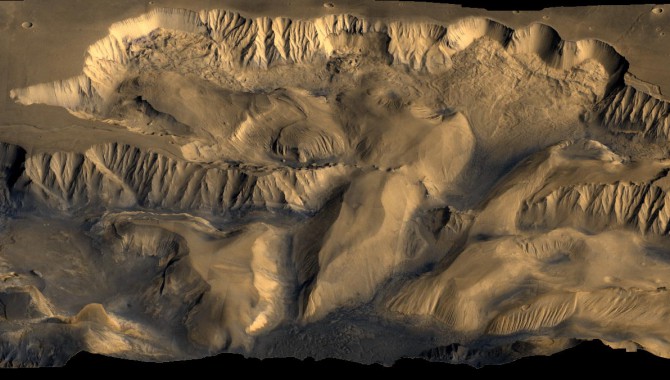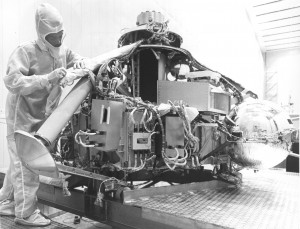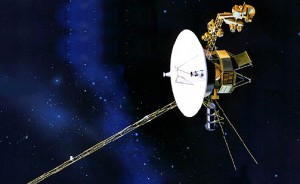
By Dr. C. Howard Robins, Jr.
The primary factor in project success is the quality of program and project management. Quality begins with excellent human resources, but effective processes are also critical.

This color mosaic of Viking Orbiter 1 and 2 images shows Candor Chasma, part of the Valles Marineris system on Mars.
Photo Credit: NASA
Since NASA’s founding in 1958, the Agency has undertaken various efforts to develop, maintain, and improve program and project management policies and processes to help ensure project success. These efforts can be grouped in four eras: an aggressive initial development in the Apollo era; maintenance-level actions during the post-Apollo era of the 1970s and 1980s; a proactive period of reformulation in the faster, better, cheaper era of the 1990s; and the current era, which began with a recognition of the limitations of faster, better, cheaper and is establishing processes to help achieve the Vision for Space Exploration.
The Apollo Era: 1958–1969
NASA’s first formal system of program/project management was introduced in three stages between 1960 and 1968 in response to the need for standards and discipline in managing the complex, expensive, and ambitious programs of the Apollo era. The first stage saw the introduction of the Program Management System (PMS) in 1960. Basically a reporting system, the PMS was NASA’s first disciplined system to address program management.
The second stage came in 1961, with the development of the Project Planning and Implementation System (PPIS). This primarily added authorization to the existing PMS and was created partly in response to external reports recommending that procurement be strengthened and project management be tightened. The PPIS also created policies and processes for agency-level approval and for project planning and implementation. The system was modified several times to include the Program Evaluation and Review Technique (PERT) and the Program Approval Document (PAD), along with changes to simplify the system and to integrate time and cost, a major step in establishing a total project management system.
The third stage was marked by the introduction of Phased Project Planning (PPP) in 1965. Previously informal practices were formalized via a NASA Policy Directive (NPD) as one of several responses to significant 1964 problems: major delays in Apollo and the fourth consecutive Rangerfailure. The formal guidelines were intended to make practice more uniform and to give management an additional intervention point in the project life cycle. The PPP policy was not fully established until 1968, the year of Administrator James E. Webb’s departure, through a revision to the NPD and issuance of a handbook. This policy has been attributed to Webb’s determination to regain control of the Agency, which he believed he had lost sometime before the Apollo 1 fire of 1967.
The success of the effort to develop these policies and processes can be primarily attributed to Webb’s strong focus on agency organization and program management and his determination to establish a disciplined program management system. Most of the program/project management staff from that era I have spoken with feel that discipline in adhering to policy and processes was maintained, and program and project managers were very much in charge of their respective programs and projects. By the end of the era, mission success (technical performance) had improved.
The Post-Apollo Era: 1970–1991
The policies and processes of the Apollo era underwent minor revisions in 1972 and again in 1977, but significant reevaluation did not occur until Congressional concerns arose in the late 1970s over both Space Shuttle program management and the cost and schedule performance of robotic flight projects. These concerns resulted in three studies: the 1979 Shuttle Program Management Assessment, the 1980 NASA Colloquium on Project Management, and the 1981 NASA Project Management Study of robotics missions. Collectively, these studies found problems in almost every area of program/project management, and the latter two indicated needs for policy revisions.
The 1979 Shuttle Program Management Assessment, performed in response to cost increases and schedule delays, found budgeting, management, and personnel problems. These findings included clear violations of good program/project management practice. However, follow-up was essentially limited to strengthening the program budgeting staff.

This picture of Neptune was produced from the last whole planet images taken through the green and orange filters on the Voyager 2 narrow angle camera.
Photo Credit: NASA
The 1980 Colloquium on Project Management was held to prepare for restarting the Program Management Shared Experience Program (PMSEP), the first agencywide program/project management training program. The colloquium identified a number of problems, but some of its recommendations were not implemented until thirteen years later.
The 1981 Project Management Study, colloquially referred to as the “Hearth Study,” would come to be viewed within NASA as a landmark. It was undertaken in response to Congressional requests resulting from concerns about cost and schedule performance problems. It was the first multiproject study of program/project management by the Agency and also the first study of the topic by an agencywide NASA team. At the direction of NASA Administrator Robert Frosch, Langley Research Center Director Donald P. Hearth led a team that studied thirteen robotic projects, including projects such as Viking and Voyager, undertaken over a twenty-two-year period. Hearth was chosen at least in part to minimize the potential for center bias; Langley did not have any space flight projects in development at the time.
The study found significant problems, including inadequate project definition, overoptimism during advocacy, and low contractor bids. However, it also found NASA performance was good overall, that cost growth may have increased but the evidence was inconclusive, that agency inability to estimate project cost was not a problem when a project was well defined, and that no new management tools or layers were required. Of particular note, the team stressed the importance of good people, continuous top management verification of the application of sound management principles, and the use of available management tools.
The study made nine recommendations, one of which was to “reexamine, revise, and reissue” the NASA Management Instruction (NMI) that covered program/project management policy. Although the initial policy update was ready a year later, the NMI revision was not issued until 1985—four years and two months after the study had been completed—due to poor follow-up by senior management. The revision was completed only after Hearth himself took it on as a short-term special assignment immediately prior to his retirement.
After the Hearth Study, no significant activity occurred in formal project and program management processes until after the 1986 Challenger accident. The loss of Challenger spurred three studies: a 1986 study of NASA organization and management, a 1988 study of NASA Headquarters, and a 1989 study of program control. They were sponsored by Administrator Dr. James Fletcher, who was brought in following the accident. All were performed under the auspices of the National Academy of Public Administration and led by former NASA Headquarters executives who had played key program/project management roles while at the Agency. Many recommendations accompanied these studies, including improving discipline and responsiveness of the program/project management system, but follow-through was generally poor. A notable exception was the establishment of a formal program and project management training program, which continues to function today.
The Faster, Better, Cheaper Era: 1992–2001
In the early 1990s, cost overruns and schedule slips, which were forgiven in the Cold War era if mission performance requirements were met, became unacceptable. Daniel Goldin was appointed Administrator in 1992 with a mandate to change the Agency. He introduced the “Faster, Better, Cheaper” (FBC) concept at NASA as well as thirteen continuous improvement initiatives, including one devoted to program/project management improvement.
The program/project management improvement initiative included a 1992 internal study that identified eight major factors driving program cost and technical risk. Of particular importance, it noted the issue of problem repetition: similar findings had been widely documented over the past fifteen years, and many had been reflected in NASA policies and processes. This persistence of previously identified problems signaled to senior management a breakdown in policy/process discipline. In 1993 this led to a major revision of basic program/project management policy, establishment of the Agency Program Management Council (PMC), and reassignment of ownership for these policies and processes to the Office of the Administrator. The follow-up actions did not include an effort to determine the specific causes of the breakdowns in discipline in policy/process implementation, however.
Extensive reviews, audits, and investigations throughout the 1990s on the Space Shuttle, International Space Station, and Mars programs found that these lapses continued. Most importantly, a number of these studies also found that many of the problems would not have occurred if existing policies and processes had been followed.
Prior to completion of the 1992 study, Goldin established a Program Excellence Team (PET) to strengthen, streamline, and consolidate the policies and processes governing management of major system development projects. In my role as deputy associate administrator for Space Systems Development, I led the PET, which consisted of senior headquarters and field center program/project management executives. The team developed a consolidated NASA program/project management policy (NMI) and supporting handbook (NHB) for implementing policies and processes that were approved in late 1993 and subsequently underwent the most extensive rollout to date. The new NMI consolidated existing program/project management policies and processes, eliminated artificial separations that existed between program/project management and acquisition, and placed responsibility for the integrated policy with the deputy administrator in his role as the Agency’s senior acquisition official.
These new policy/process documents reflected the results of all studies, colloquia, reviews, investigations, and audits subsequent to the 1981 Hearth effort. Extensive policy changes included the introduction of life-cycle costing, reestablishment of PPP, selection of “Down Select” (narrowing the field for selection of a contractor through successive competitive phases) as the normal acquisition mode, and establishment of requirements for independent reviews and cost estimates. Even these changes did not meet all policy needs.
In developing the new program/project management policy and handbook, the PET found problems in every aspect of the program/project management function: policy, implementation, and training. The team also found that the repetition of program/project management problems was due to the stress of performing in a very difficult environment combined with a lack of senior management ownership of policy documentation. The new policy addressed this issue by assigning overall program/project management responsibility to the deputy administrator. Acting Deputy Administrator General John Dailey subsequently established a PMC Working Group (PMCWG) and used the Office of the Chief Engineer, a part of the Office of the Administrator, to support him in meeting this responsibility.
Shortly after the PMCWG was established, the Administrator made two decisions that would necessitate a major revision of the new program/project management policy: program management responsibility would shift from headquarters to the field centers, and NASA was to implement a strategic-planning process that would eliminate the existing life-cycle approach to program/project management.
The program/project management policy revision needed to effect these changes was developed by the PMCWG and issued in 1996 as a NASA Policy Directive (NPD 7120.4A). This revision expanded the policy scope to all agency programs and projects and replaced the five phases of the life cycle with the four component processes of the strategic management process for program/project management. It was significantly briefer than the PET-generated version it replaced, with the expectation that the deleted material would be updated and included later in the needed revision of the Program/Project Management Handbook. However, when the PMCWG updated the handbook in 1998, much of the deleted material was not included. The review rollout process for NASA Procedures and Guidelines (NPG) 7120.5A, the precursor to today’s 7120.5D, was personally led by the acting deputy administrator and was the most comprehensive ever.
Lessons for the Road Ahead
What can be learned from reviewing these efforts? First, NASA has no trouble identifying its weaknesses. The “usual suspects” appear repeatedly in these assessments: inadequate program/project definition, complex or unclear roles and responsibilities, budget instability and inadequate resource reserves, inadequate program/project control, inadequate risk management, poor implementation of management and engineering processes and practice, and poor communication. Other persistent problems include discipline breakdowns, a lack of agency buy-in, inadequate training resources, inappropriate management approaches, organizational fragmentation, and deficiencies in the policies and processes themselves. Where problems are concerned, there is nothing new under the sun.
Second, this repeated identification of the same problems indicates that additional top-level agency management attention to program/project management improvement is essential to the success of the Vision for Space Exploration programs. The increased attention that NASA Administrator Dr. Michael Griffin is devoting to the improvement of program/project management and systems engineering is very encouraging. The breadth and depth of the ongoing improvement efforts and their strong support from the Administrator are the critical prerequisites to their success, as were the similar efforts of Administrator James Webb on behalf of the Apollo program.











